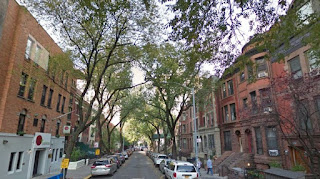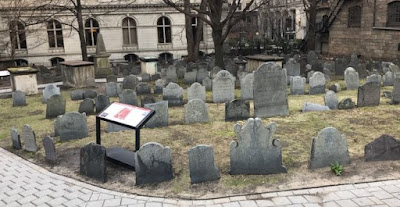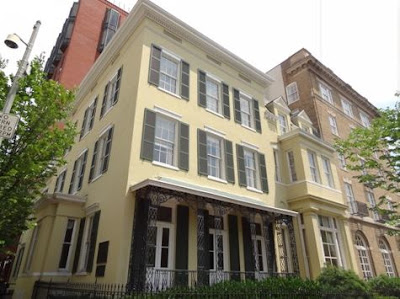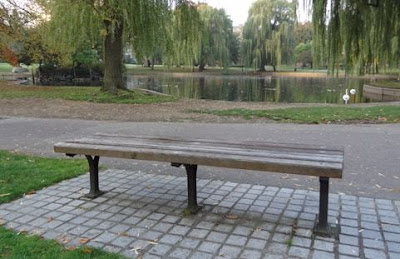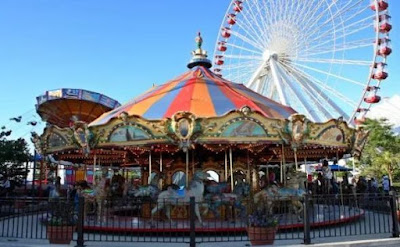Our interest in the address at 115 West 95th Street is not for its current resident, the Studio School, which moved here in 1971 from the Village. Our interest more lies in the former home, which resided here in 1897.
Stepping back a few years in the late 19th century, this area used to contain a long series of brownstones with red-brick. These houses actually ran from 111-121 West 95th Street and were designed by architect Charles T. Mott. In 1896, a family of three moved into the residence at 115. The family consisted of Dr. Philip F. O’Hanlon, his wife Laura, and their 8-year-old daughter, Virginia. The following year after they moved in, Virginia posed that dreaded question to her father, “Daddy is Santa Claus real?” Dr. O’Hanlon utilized his quick-witted parenting skills by deferring to the New York Sun and recommended his daughter send them a letter to inquire. In that letter published on September 21, the New York Sun posted a Virginia’s letter with a heartwarming response.
In her letter Virginia inquired, Dear Editor: I am 8 years old. Some of my little friends say there is no Santa Claus. Papa says, If you see it in The Sun it so. Please tell me the truth; is there a Santa Claus?
The response provided read, in part, was as follows, “Virginia, your little friends are wrong. They have been affected by the skepticism of a skeptical age. They do not believe except they see… Yes, Virginia, there is a Santa Claus. He exists as certainly as love and generosity and devotion exist… Alas! How dreary would be the world if there were no Santa Claus. It wailed as dreary if there were no Virginias… Not believe in Santa Claus! You as well not believe in fairies! No Santa Claus! Thank God! He lives, and he lives forever. A thousand years from now, Virginia, nay, ten times ten thousand years from now, he will continue to make glad the heart of childhood.”
That famous response, although unsigned, was long believed to have been drafted by an editor named Francis P. Church. Based upon the overwhelming feedback from Sun readers, the letters were reprinted every year in the newspaper until 1950.
In regards to whatever happened to Virginia. She did continue to believe in Santa Claus and she shared her story countless times by re-reading the article to children. She went on to become a teacher herself before she passed away in 1971.
Stepping back a few years in the late 19th century, this area used to contain a long series of brownstones with red-brick. These houses actually ran from 111-121 West 95th Street and were designed by architect Charles T. Mott. In 1896, a family of three moved into the residence at 115. The family consisted of Dr. Philip F. O’Hanlon, his wife Laura, and their 8-year-old daughter, Virginia. The following year after they moved in, Virginia posed that dreaded question to her father, “Daddy is Santa Claus real?” Dr. O’Hanlon utilized his quick-witted parenting skills by deferring to the New York Sun and recommended his daughter send them a letter to inquire. In that letter published on September 21, the New York Sun posted a Virginia’s letter with a heartwarming response.
In her letter Virginia inquired, Dear Editor: I am 8 years old. Some of my little friends say there is no Santa Claus. Papa says, If you see it in The Sun it so. Please tell me the truth; is there a Santa Claus?
The response provided read, in part, was as follows, “Virginia, your little friends are wrong. They have been affected by the skepticism of a skeptical age. They do not believe except they see… Yes, Virginia, there is a Santa Claus. He exists as certainly as love and generosity and devotion exist… Alas! How dreary would be the world if there were no Santa Claus. It wailed as dreary if there were no Virginias… Not believe in Santa Claus! You as well not believe in fairies! No Santa Claus! Thank God! He lives, and he lives forever. A thousand years from now, Virginia, nay, ten times ten thousand years from now, he will continue to make glad the heart of childhood.”
That famous response, although unsigned, was long believed to have been drafted by an editor named Francis P. Church. Based upon the overwhelming feedback from Sun readers, the letters were reprinted every year in the newspaper until 1950.
In regards to whatever happened to Virginia. She did continue to believe in Santa Claus and she shared her story countless times by re-reading the article to children. She went on to become a teacher herself before she passed away in 1971.
- Website: http://www.newseum.org/yesvirginia/
- Address: 115 West 95th Street, New York City
- Cost: Free.

